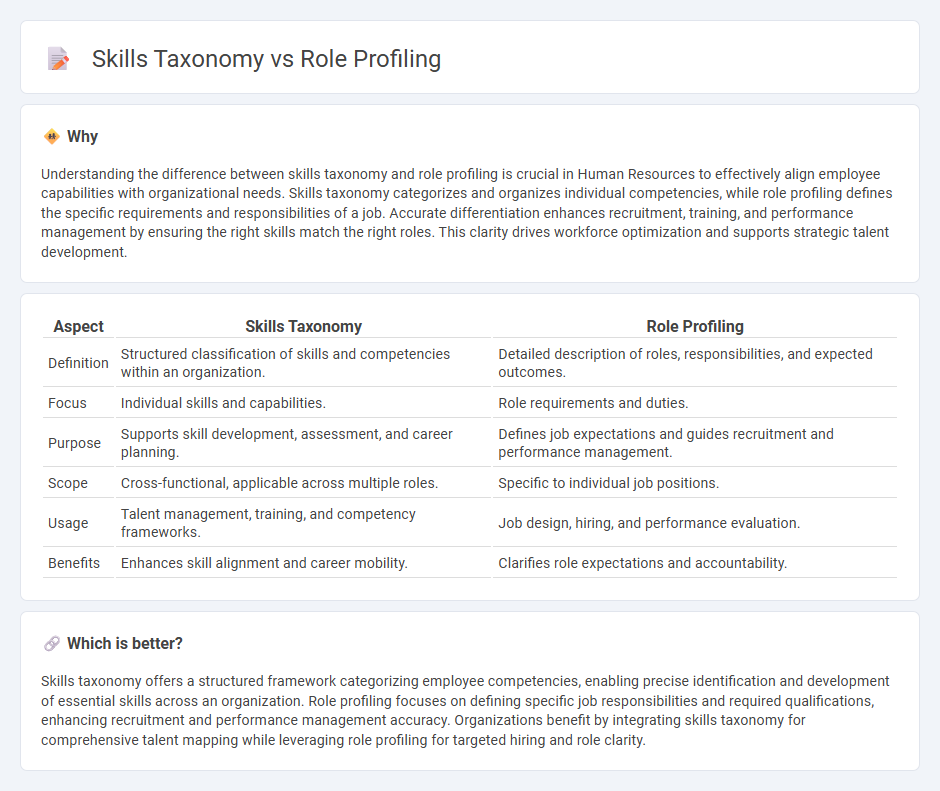
Skills taxonomy structures and categorizes employee abilities to enhance talent management and workforce planning, facilitating precise skill gap analysis and targeted development programs. Role profiling defines specific job responsibilities, performance expectations, and required competencies to align recruitment and training with organizational goals. Explore how integrating skills taxonomy and role profiling can optimize human resource strategies effectively.
Why it is important
Understanding the difference between skills taxonomy and role profiling is crucial in Human Resources to effectively align employee capabilities with organizational needs. Skills taxonomy categorizes and organizes individual competencies, while role profiling defines the specific requirements and responsibilities of a job. Accurate differentiation enhances recruitment, training, and performance management by ensuring the right skills match the right roles. This clarity drives workforce optimization and supports strategic talent development.
Comparison Table
| Aspect | Skills Taxonomy | Role Profiling |
|---|---|---|
| Definition | Structured classification of skills and competencies within an organization. | Detailed description of roles, responsibilities, and expected outcomes. |
| Focus | Individual skills and capabilities. | Role requirements and duties. |
| Purpose | Supports skill development, assessment, and career planning. | Defines job expectations and guides recruitment and performance management. |
| Scope | Cross-functional, applicable across multiple roles. | Specific to individual job positions. |
| Usage | Talent management, training, and competency frameworks. | Job design, hiring, and performance evaluation. |
| Benefits | Enhances skill alignment and career mobility. | Clarifies role expectations and accountability. |
Which is better?
Skills taxonomy offers a structured framework categorizing employee competencies, enabling precise identification and development of essential skills across an organization. Role profiling focuses on defining specific job responsibilities and required qualifications, enhancing recruitment and performance management accuracy. Organizations benefit by integrating skills taxonomy for comprehensive talent mapping while leveraging role profiling for targeted hiring and role clarity.
Connection
Skills taxonomy establishes a structured framework that categorizes and defines specific competencies required across various roles, enabling precise role profiling that outlines job responsibilities and skill demands. This connection enhances talent management by aligning employee capabilities with organizational needs, facilitating targeted recruitment, training, and career development. Effective integration of skills taxonomy and role profiling drives workforce optimization and supports strategic human resource planning.
Key Terms
Role Profiling:
Role profiling systematically defines specific responsibilities, competencies, and performance expectations for individual job roles to enhance recruitment and development processes. It creates clear, structured role descriptions aligned with organizational objectives, enabling precise talent management and succession planning. Discover how role profiling transforms workforce strategy and optimizes employee potential.
Job Description
Role profiling defines the specific responsibilities, expectations, and competencies associated with a particular job, ensuring clear alignment with organizational goals. Skills taxonomy categorizes and organizes the various abilities and knowledge areas vital for job performance, enhancing consistency in job descriptions and talent management. Discover how integrating role profiling with skills taxonomy can transform job descriptions and optimize recruitment strategies.
Key Responsibilities
Role profiling emphasizes detailed key responsibilities to define job expectations and performance criteria for specific positions. Skills taxonomy categorizes competencies broadly, enabling alignment of employee skills with organizational needs but may lack granularity in daily duties. Explore how integrating both approaches optimizes workforce planning and development strategies.
Source and External Links
Role-based skill profiling - This approach involves identifying, documenting, and evaluating specific skills needed for effective performance in a particular job role, creating a detailed profile for success.
How job profiling can help you get the right person in the right place - Job profiling provides insight into the behavioral characteristics needed to fill a specific position, aiding in recruitment by aligning expectations and requirements.
Job Profiling/Job Analysis - This process establishes links between job requirements and the necessary knowledge, skills, and behavioral characteristics for successful performance, guiding HR management systems.
 dowidth.com
dowidth.com